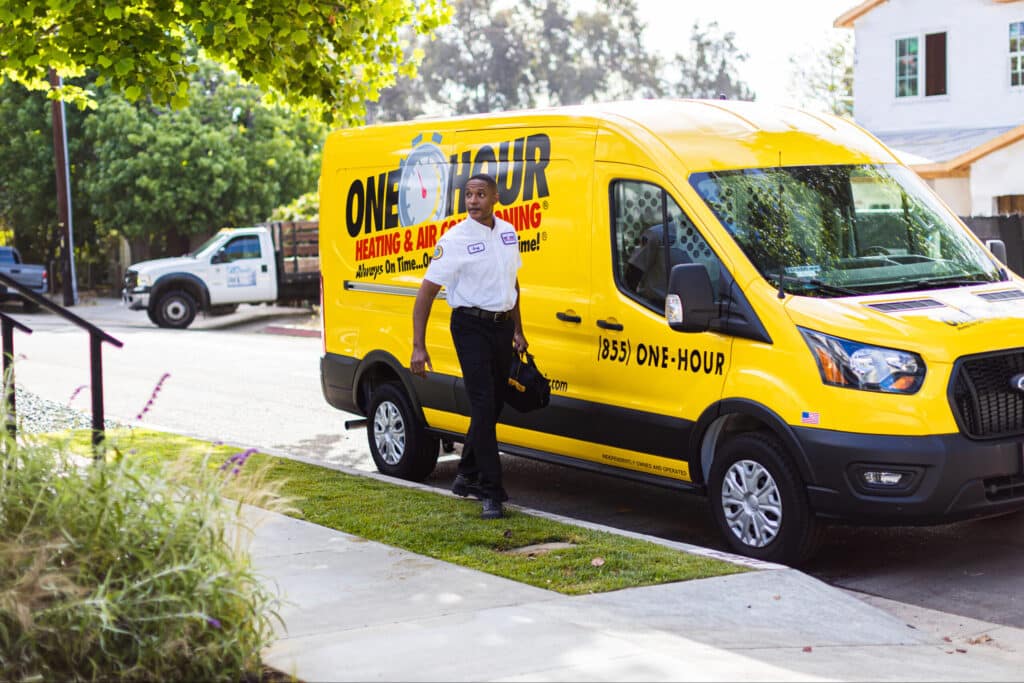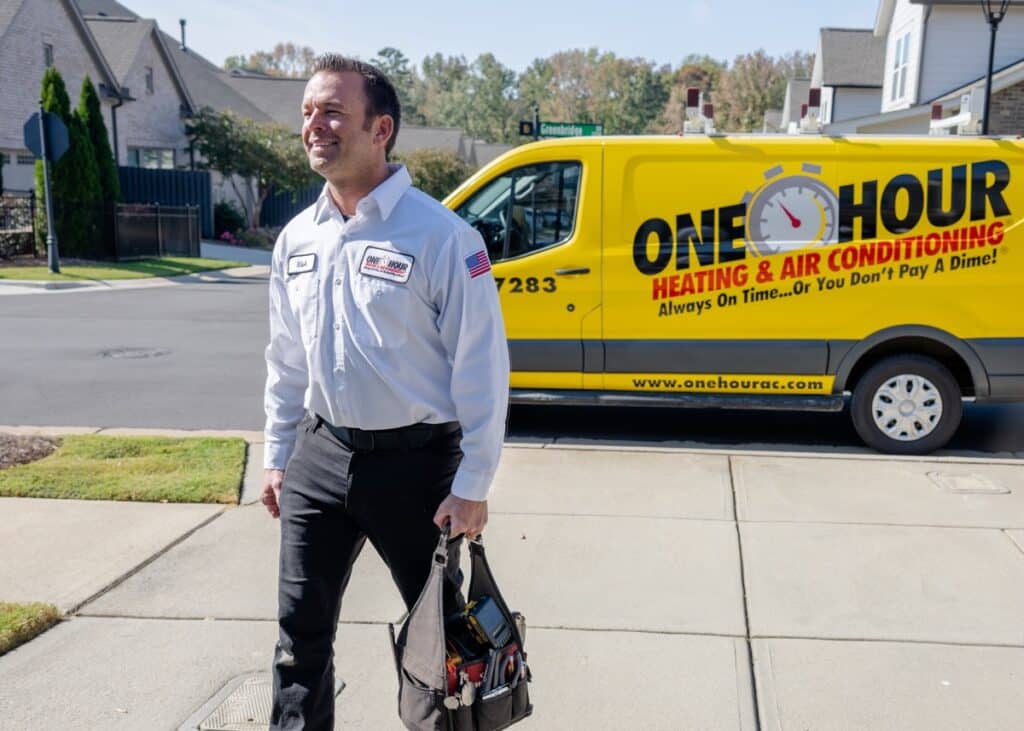Searching for HVAC Repair near me? One Hour Heating & Air Conditioning provides fast, reliable, and professional HVAC services to keep your home comfortable year-round. Whether you need emergency repairs, routine maintenance, or a brand-new system, our expert technicians are ready to help. We proudly serve Cockeysville, MD, and surrounding areas, ensuring top-quality service and customer satisfaction. Trust us for all your heating and cooling needs—on time, every time!

What Is an HVAC Zoning System?
An HVAC zoning system allows you to divide your home or business into separate temperature-controlled areas. Instead of heating or cooling the entire space evenly, zoning lets you control specific rooms or sections independently. This system is particularly useful for multi-level homes, large properties, and buildings with varying temperature needs. By tailoring the climate in different areas, you can enhance comfort while reducing energy waste.
Zoning systems use a network of dampers within the ductwork to direct airflow to specific zones. Each zone has its own thermostat, which communicates with the central HVAC system to regulate temperature as needed. This targeted approach prevents hot and cold spots, making every part of your home or office more comfortable. Whether it’s a sun-soaked living room or a rarely used guest bedroom, each area gets the precise temperature control it requires.
Homeowners and business owners often choose zoning systems to improve efficiency and cut down on energy bills. Without zoning, your HVAC system runs at full capacity to condition all spaces, even those that don’t need it. With zoning, you only heat or cool the areas in use, which can lead to significant savings over time. In addition to cost benefits, zoning extends the lifespan of your HVAC system by reducing overall strain.
If you experience temperature inconsistencies throughout your property, an HVAC zoning system may be the perfect solution. It eliminates the constant battle over thermostat settings, ensuring that everyone remains comfortable. Whether you want to customize the climate for different family members or optimize heating and cooling in a commercial space, zoning provides a flexible and effective solution. Investing in a zoning system can make your HVAC system smarter and more adaptable to your needs.
How Does an HVAC Zoning System Work?
An HVAC zoning system works by controlling airflow through a series of dampers installed within the ductwork. These dampers open and close based on signals from individual thermostats placed in each zone. When a zone needs heating or cooling, the system directs air to that specific area while restricting it in others. This process allows different rooms or sections of a building to maintain unique temperatures without affecting the entire property.
Each thermostat operates independently but is connected to a central control panel that manages the system. When a specific zone reaches its desired temperature, the damper for that zone closes, stopping airflow to that section. Meanwhile, dampers in zones still requiring heating or cooling remain open, allowing conditioned air to flow where it’s needed. This level of precision improves efficiency and helps maintain consistent comfort throughout the building.
Most modern zoning systems integrate with smart thermostats, making it easier to control temperatures remotely. Some systems even use sensors to detect occupancy and adjust settings automatically. This technology prevents energy waste by reducing HVAC usage in empty rooms. With the ability to program temperature settings for different times of the day, homeowners and businesses can achieve greater efficiency without constant manual adjustments.
Unlike traditional single-zone HVAC setups, zoning minimizes unnecessary heating and cooling, reducing wear and tear on the system. It helps eliminate the issue of some rooms feeling too warm while others remain cold. Whether you’re dealing with different sun exposure levels or varying room usage, zoning adapts to your unique needs. The result is a more responsive and energy-efficient HVAC system that enhances comfort and lowers energy costs.

How HVAC Zoning Systems Work
HVAC zoning systems divide your home into separate climate-controlled areas, allowing for customized temperature settings in each zone. This is achieved using dampers in the ductwork that regulate airflow to different sections of the house. A central control panel communicates with multiple thermostats, adjusting temperatures as needed for comfort and efficiency. By directing heated or cooled air only where it’s needed, zoning systems help eliminate hot and cold spots while reducing energy waste.
Each zone has its own thermostat, giving homeowners full control over individual room temperatures. This setup is especially useful for multi-story homes, where upper floors often feel warmer than lower ones. Instead of relying on a single thermostat to manage the entire home’s climate, zoning ensures each area receives the right amount of heating or cooling. This not only improves comfort but also prevents temperature fluctuations throughout the house.
The system works by using motorized dampers installed inside the ductwork. These dampers open and close to allow or restrict airflow based on the thermostat settings in each zone. When one area reaches the desired temperature, the damper partially or fully closes, redirecting air to other areas still requiring heating or cooling. This intelligent distribution of air prevents unnecessary energy usage and improves overall efficiency.
For maximum performance, zoning systems are often integrated with smart thermostats. These thermostats can be programmed to adjust temperatures automatically throughout the day. Some even have learning capabilities, detecting usage patterns to optimize heating and cooling schedules. Combined with zoning, smart controls offer an advanced level of convenience and energy savings.
Benefits of HVAC Zoning Systems
Zoning systems enhance comfort by providing personalized temperature control in different areas of your home. No more arguing over thermostat settings—each family member can enjoy their preferred climate in their own space. Whether it’s a warm bedroom for better sleep or a cool living room for relaxation, zoning allows homeowners to create ideal indoor conditions. This tailored comfort is one of the biggest advantages of installing a zoning system.
Energy efficiency is another major benefit of zoning systems. Traditional HVAC systems waste energy by heating or cooling the entire home, even when only a few rooms are in use. Zoning eliminates this inefficiency by sending air only where it’s needed, reducing the system’s overall workload. As a result, homeowners often see a noticeable drop in their energy bills after switching to a zoning system.
By reducing strain on your HVAC equipment, zoning systems also extend the lifespan of your heating and cooling units. Since the system doesn’t have to work as hard to maintain consistent temperatures, components experience less wear and tear over time. This means fewer repairs, lower maintenance costs, and a longer-lasting HVAC system. Investing in zoning can save money not only on energy costs but also on future repair and replacement expenses.
Finally, zoning improves indoor air quality by limiting airflow between different sections of the home. This can help reduce the spread of allergens, dust, and pet dander. With less forced air circulation throughout the entire house, contaminants are more contained within specific zones. For allergy sufferers or those with respiratory issues, zoning can create a cleaner, healthier living environment.

Types of HVAC Zoning Systems
HVAC zoning systems come in different configurations, allowing homeowners to choose the best fit for their needs. The two primary types are ducted and ductless zoning systems. Ducted zoning uses motorized dampers within the ductwork to control airflow, adjusting temperatures in different parts of the home. This type is ideal for homes with existing duct systems, as it can be integrated with a central HVAC unit.
Ductless zoning, on the other hand, relies on mini-split systems to provide targeted heating and cooling. Each zone has its own indoor air handler connected to an outdoor compressor, eliminating the need for ductwork. This option is perfect for older homes without central air or for room additions where extending ducts would be costly. Ductless systems also offer independent climate control, giving homeowners flexibility in temperature management.
Some zoning systems use a combination of both ducted and ductless solutions for maximum efficiency. Hybrid setups are beneficial in homes with varying heating and cooling needs across different areas. For example, a main living area might be served by a central ducted system, while an attic or basement could have a ductless unit. This approach provides customized comfort without requiring a complete HVAC system overhaul.
Smart zoning systems take temperature control to the next level by integrating advanced technology. These systems use sensors and automated controls to adjust heating and cooling based on occupancy, weather, and time of day. With smart thermostats and remote access, homeowners can manage their zones conveniently from a smartphone or voice-controlled device. The ability to fine-tune temperatures in real time enhances energy savings and overall comfort.
Signs Your Home Could Benefit from HVAC Zoning
If certain rooms in your home are consistently too hot or too cold, a zoning system may be the solution. Uneven temperatures are often caused by poor airflow distribution, insulation differences, or multi-story layouts. Instead of relying on a single thermostat to balance temperatures, zoning allows each area to be adjusted independently. This can eliminate common discomforts like chilly basements and overheated upstairs bedrooms.
Large homes with multiple living spaces are excellent candidates for HVAC zoning. Traditional systems struggle to maintain uniform temperatures in houses with expansive layouts. Zoning helps by dividing the home into manageable sections, ensuring each space receives the appropriate heating or cooling. This is especially useful in homes with open floor plans, vaulted ceilings, or extensive glass windows that affect temperature regulation.
Households with different temperature preferences can also benefit from zoning. If family members frequently disagree over thermostat settings, a zoned system provides a practical solution. Instead of forcing one setting for the entire house, zoning allows individuals to control their own spaces. This personalized comfort can enhance everyday living while preventing thermostat-related conflicts.
Energy-conscious homeowners looking to reduce their carbon footprint should also consider zoning. By directing air only where it’s needed, these systems minimize waste and lower energy consumption. This leads to significant savings on utility bills while promoting environmentally friendly heating and cooling practices. Over time, the reduced strain on HVAC equipment also decreases the need for repairs and replacements.

How HVAC Zoning Improves Energy Efficiency
HVAC zoning systems optimize energy use by heating and cooling only the areas that need it. Traditional systems operate on a one-size-fits-all approach, often wasting energy on unoccupied or rarely used rooms. With zoning, homeowners can set different temperatures for specific areas, reducing unnecessary energy consumption. This targeted approach helps lower utility bills while extending the lifespan of the HVAC system.
Zoned systems work by using dampers or independent air handlers to control airflow. When a particular zone reaches its desired temperature, the system reduces output to that area, preventing over-conditioning. This reduces the constant cycling of the HVAC system, which is a major contributor to high energy costs. Less frequent cycling also means less wear and tear on essential components like the compressor and blower motor.
Smart thermostats further enhance zoning efficiency by learning usage patterns and adjusting settings automatically. These devices detect occupancy levels and outdoor weather conditions to optimize heating and cooling. Homeowners can also program schedules or control settings remotely, ensuring that energy is not wasted when no one is home. This level of automation allows for maximum comfort with minimal energy expenditure.
Proper zoning setup can result in energy savings of up to 30% compared to traditional HVAC systems. By minimizing waste and directing airflow efficiently, zoning systems make homes more sustainable. They also help maintain balanced indoor temperatures year-round, reducing the need for constant thermostat adjustments. Over time, the investment in zoning pays off through lower bills and improved system performance.
Installing an HVAC Zoning System in Your Home
The process of installing an HVAC zoning system depends on whether your home has existing ductwork. For homes with central air, technicians install motorized dampers inside the duct system to regulate airflow. Each zone is connected to a thermostat that communicates with the main control panel. This setup allows precise temperature management in different areas without requiring major modifications.
For homes without ductwork, ductless mini-split systems are the best option. These systems require mounting individual air handlers in each zone, which connect to an outdoor compressor. Installation is relatively quick, as there’s no need for extensive renovations or new duct installations. Mini-split systems also provide flexibility, allowing homeowners to expand their zoning system as needed.
During installation, HVAC professionals assess factors like home layout, insulation, and window placement. Proper zoning design ensures that each area receives adequate heating and cooling without overloading the system. In some cases, a hybrid approach combining ducted and ductless zoning may be recommended for optimal efficiency. Customizing the system to fit specific home requirements maximizes comfort and energy savings.
Once installed, homeowners should schedule regular maintenance to keep the zoning system running smoothly. This includes cleaning filters, inspecting dampers, and ensuring thermostat settings remain accurate. Routine check-ups help prevent airflow issues and maintain consistent performance. A well-maintained zoning system can provide years of energy-efficient climate control with minimal disruptions.

Best Thermostats for HVAC Zoning Systems
Choosing the right thermostat is essential for maximizing the efficiency of an HVAC zoning system. Standard thermostats only control a single temperature for the entire home, but zoned systems require multiple thermostats. Each zone needs an independent thermostat to regulate airflow and maintain the desired temperature. Smart thermostats are an excellent option, offering advanced features like remote access, scheduling, and learning capabilities.
Wi-Fi-enabled thermostats allow homeowners to adjust temperatures from anywhere using a smartphone or tablet. This feature is especially useful for households with varying occupancy patterns. For example, if a homeowner forgets to adjust the temperature before leaving, they can make changes remotely. This helps prevent energy waste and ensures comfort upon return. Some smart thermostats can even sync with weather forecasts to optimize heating and cooling automatically.
Zoning-compatible thermostats often include motion sensors to detect when a room is occupied. This allows them to adjust temperatures based on real-time usage, reducing energy consumption in empty areas. Advanced models also integrate with home automation systems, allowing voice control through devices like Amazon Alexa or Google Assistant. These features improve convenience while ensuring efficient climate control throughout the home.
When selecting a thermostat for a zoning system, it’s important to consider compatibility with existing HVAC equipment. Some models work best with specific brands or require additional control panels for integration. Consulting an HVAC professional can help homeowners choose the right thermostat for their zoning setup. A properly selected thermostat enhances comfort, reduces energy costs, and ensures smooth operation of the zoning system.
Is an HVAC Zoning System Right for Your Home?
HVAC zoning systems are ideal for homes with diverse heating and cooling needs. If certain rooms always feel too hot or too cold compared to the rest of the house, zoning can help. Homes with large square footage, multiple stories, or open floor plans benefit the most from customized climate control. Instead of setting one temperature for the entire home, zoning allows each area to maintain its preferred comfort level.
Households with different temperature preferences can also benefit from zoning systems. If one person prefers a cooler bedroom while another likes a warmer living room, zoning eliminates the need for compromise. Each zone operates independently, providing personalized comfort for every member of the household. This feature is especially useful for families with young children or elderly individuals who require specific temperature settings.
Older homes with inconsistent airflow or hot and cold spots may also benefit from zoning. However, installing a zoning system in an existing home may require ductwork modifications. In contrast, new home constructions can incorporate zoning from the start, ensuring optimal placement of dampers and thermostats. Consulting an HVAC professional helps determine whether zoning is a feasible solution for a particular home.
While zoning systems require an initial investment, they provide long-term comfort and efficiency. The energy savings alone can offset the upfront cost over time. Homeowners looking for better temperature control, lower energy bills, and increased HVAC system longevity should consider upgrading to a zoning system. Proper installation and maintenance ensure optimal performance for years to come.





